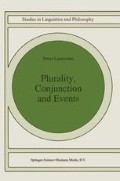Abstract
One potential objection to the NP/S Analysis, perhaps more likely to be made by philosophers than linguists, is that it requires an ontological conunitment to the existence of groups. For example, (the non-contradictory reading of) John and Mary are a couple is analyzed as involving reference to the “group” of John and Mary. This group is an entity distinct from John and distinct from Mary, which the NP/S Analysis claims can have its own properties, independent of the properties of its members.
Access this chapter
Tax calculation will be finalised at checkout
Purchases are for personal use only
Preview
Unable to display preview. Download preview PDF.
Notes
It should be emphasized that the analyses given by these authors differ from one another both in substance and in motivation; and that the arguments given below against the Relational/S Analysis do not all apply to all of these authors' proposals. It should also be noted that Massey advocates a Relational/S Analysis only for certain examples, and an NP/S Analysis for others. Avoiding the claim that plural noun phrases refer to groups is also a central concern for Schein (1986, 1992, 1994), and Higginbotham and Schein (1989), but in this case the motivation is not ontological, and the analysis is not of the Relational/S variety. (It will be discussed in Chapters 4 and 7, below.) See also Boolos (1984, 1985a, 1985b) for relevant discussion.
See Morton (1975) for a presentation of how this can be done formally Of course even without this revision there is no requirement that sulface predicates must have a fixed number of argument places, since a surface predicate may correspond to more than one distinct predicate in logical form.
Author information
Authors and Affiliations
Rights and permissions
Copyright information
© 1995 Springer Science+Business Media Dordrecht
About this chapter
Cite this chapter
Lasersohn, P. (1995). The Relational/S Analysis. In: Plurality, Conjunction and Events. Studies in Linguistics and Philosophy, vol 55. Springer, Dordrecht. https://doi.org/10.1007/978-94-015-8581-1_3
Download citation
DOI: https://doi.org/10.1007/978-94-015-8581-1_3
Publisher Name: Springer, Dordrecht
Print ISBN: 978-90-481-4494-5
Online ISBN: 978-94-015-8581-1
eBook Packages: Springer Book Archive

